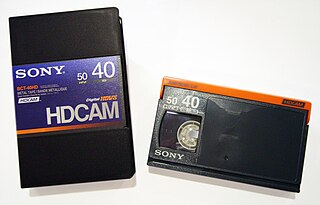Related Research Articles

Digital video is an electronic representation of moving visual images (video) in the form of encoded digital data. This is in contrast to analog video, which represents moving visual images in the form of analog signals. Digital video comprises a series of digital images displayed in rapid succession, usually at 24, 25, 30, or 60 frames per second. Digital video has many advantages such as easy copying, multicasting, sharing and storage.

NTSC is the first American standard for analog television, published and adopted in 1941. In 1961, it was assigned the designation System M. It is also known as EIA standard 170.

Video is an electronic medium for the recording, copying, playback, broadcasting, and display of moving visual media. Video was first developed for mechanical television systems, which were quickly replaced by cathode-ray tube (CRT) systems, which, in turn, were replaced by flat-panel displays of several types.

Video CD is a home video format and the first format for distributing films on standard 120 mm (4.7 in) optical discs. The format was widely adopted in Southeast Asia, South Asia, East Asia, Central Asia and West Asia, superseding the VHS and Betamax systems in the regions until DVD-Video finally became affordable in the first decade of the 21st century.
The NewTek Video Toaster is a combination of hardware and software for the editing and production of NTSC standard-definition video. The plug-in expansion card initially worked with the Amiga 2000 computer and provides a number of BNC connectors on the exposed rear edge that provide connectivity to common analog video sources like VHS VCRs. The related software tools support video switching, luma keying, character generation, animation, and image manipulation.

Telecine is the process of transferring film into video and is performed in a color suite. The term is also used to refer to the equipment used in this post-production process.
Motion JPEG is a video compression format in which each video frame or interlaced field of a digital video sequence is compressed separately as a JPEG image.

Slow motion is an effect in film-making whereby time appears to be slowed down. It was invented by the Austrian priest August Musger in the early 20th century. This can be accomplished through the use of high-speed cameras and then playing the footage produced by such cameras at a normal rate like 30 fps, or in post production through the use of software.

A camcorder is a self-contained portable electronic device with video and recording as its primary function. It is typically equipped with an articulating screen mounted on the left side, a belt to facilitate holding on the right side, hot-swappable battery facing towards the user, hot-swappable recording media, and an internally contained quiet optical zoom lens.
Betacam is a family of half-inch professional videocassette products developed by Sony in 1982. In colloquial use, Betacam singly is often used to refer to a Betacam camcorder, a Betacam tape, a Betacam video recorder or the format itself.
ANIM is a file format, used to store digital movies and computer generated animations, and is a variation of the ILBM format, which is a subformat of Interchange File Format.
Film-out is the process in the computer graphics, video production and filmmaking disciplines of transferring images or animation from videotape or digital files to a traditional film print. Film-out is a broad term that encompasses the conversion of frame rates, color correction, as well as the actual printing, also called scannior recording.
H.262 or MPEG-2 Part 2 is a video coding format standardised and jointly maintained by ITU-T Study Group 16 Video Coding Experts Group (VCEG) and ISO/IEC Moving Picture Experts Group (MPEG), and developed with the involvement of many companies. It is the second part of the ISO/IEC MPEG-2 standard. The ITU-T Recommendation H.262 and ISO/IEC 13818-2 documents are identical.

HDCAM is a high-definition video digital recording videocassette version of Digital Betacam introduced in 1997 that uses an 8-bit discrete cosine transform (DCT) compressed 3:1:1 recording, in 1080i-compatible down-sampled resolution of 1440×1080, and adding 24p and 23.976 progressive segmented frame (PsF) modes to later models. The HDCAM codec uses rectangular pixels and as such the recorded 1440×1080 content is upsampled to 1920×1080 on playback. The recorded video bit rate is 144 Mbit/s. Audio is also similar, with four channels of AES3 20-bit, 48 kHz digital audio. Like Betacam, HDCAM tapes were produced in small and large cassette sizes; the small cassette uses the same form factor as the original Betamax. The main competitor to HDCAM was the DVCPRO HD format offered by Panasonic, which uses a similar compression scheme and bit rates ranging from 40 Mbit/s to 100 Mbit/s depending on frame rate.

Digital cinematography is the process of capturing (recording) a motion picture using digital image sensors rather than through film stock. As digital technology has improved in recent years, this practice has become dominant. Since the 2000s, most movies across the world have been captured as well as distributed digitally.
Time base correction (TBC) is a technique to reduce or eliminate errors caused by mechanical instability present in analog recordings on mechanical media. Without time base correction, a signal from a videotape recorder (VTR) or videocassette recorder (VCR), cannot be mixed with other, more time-stable devices such as character generators and video cameras found in television studios and post-production facilities.

A closed-circuit television camera is a type of surveillance camera that transmits video signals to a specific set of monitors or video recording devices, rather than broadcasting the video over public airwaves. The term "closed-circuit television" indicates that the video feed is only accessible to a limited number of people or devices with authorized access. Cameras can be either analog or digital. Walter Bruch was the inventor of the CCTV camera.
CDXL is motion video file format developed by Commodore in the late 1980s and early 1990s for the Amiga computer platform. It is notable for being one of the earliest formats created for motion video playback from CD-ROM.
Uncompressed video is digital video that either has never been compressed or was generated by decompressing previously compressed digital video. It is commonly used by video cameras, video monitors, video recording devices, and in video processors that perform functions such as image resizing, image rotation, deinterlacing, and text and graphics overlay. It is conveyed over various types of baseband digital video interfaces, such as HDMI, DVI, DisplayPort and SDI. Standards also exist for the carriage of uncompressed video over computer networks.
A Digital Cinema Package (DCP) is a collection of digital files used to store and convey digital cinema (DC) audio, image, and data streams.
References
- ↑ "Digital Processing Systems Personal Animation Recorder - Amiga Hardware Database" . Retrieved 6 June 2017.
- 1 2 3 4 5 6 7 8 Williams, Geoffrey (October 1993). "Personal Animation Recorder. TBC-IV". Amiga World . Vol. 9, no. 10. pp. 14–16.